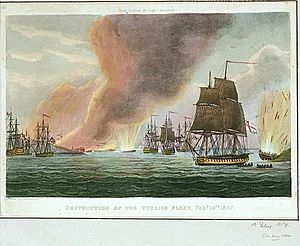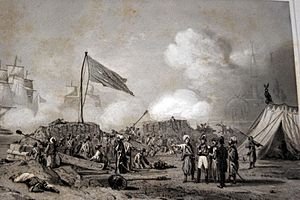Dardanelles operation facts for kids
Quick facts for kids Dardanelles operation |
|||||||
|---|---|---|---|---|---|---|---|
| Part of the Anglo-Turkish War | |||||||
 The squadron under the command of Sir J T Duckworth forcing the narrow channel of the Dardanelles, February 19th 1807, by Thomas Whitcombe |
|||||||
|
|||||||
| Belligerents | |||||||
|
|||||||
| Commanders and leaders | |||||||
| Strength | |||||||
| 8 ships of the line, 2 frigates, 2 bomb ships, 1 transport | 14 ships of the line, 9 frigates, a dozen brigs and gunboats, several hundred Ottoman siege cannons, and some modern bronze pieces | ||||||
| Casualties and losses | |||||||
| 42 killed, 235 wounded, and 4 missing | Unknown | ||||||
The Dardanelles operation was a failed attack by the British Navy against the strong forts protecting Constantinople. This event was part of the Anglo-Turkish War. It happened in 1807, when Britain tried to force the Ottoman Empire to join its side in the Napoleonic Wars.
Contents
Why Did the Dardanelles Operation Happen?
In 1806, France sent a special envoy, Sebastiani, to Constantinople. His mission was to convince the Ottoman Empire to join France in the Napoleonic Wars. The Ottoman ruler, Sultan Selim III, agreed and started preparing for war against Russia.
This worried the Russian emperor, Alexander I. He already had many soldiers fighting the French in other areas. So, Alexander asked Britain for help to keep the Ottomans out of the war.
Britain's army was too small for this task. So, the powerful Royal Navy was chosen to help. Ships like HMS Canopus and HMS Standard were sent to the Dardanelles. They prepared for a big attack.
Meanwhile, the British ambassador in Constantinople, Arbuthnot, told the Ottoman government to send Sebastiani away. He warned that if they refused, the British fleet would attack.
The British force for this operation was quite small. It had only eight large warships and four smaller frigates. Four Russian warships were also sent to help, but they arrived too late. Admiral Duckworth led the British fleet. His orders were to attack Constantinople and capture the Ottoman navy.
Setting the Scene for Battle
Britain knew a war between Russia and the Ottoman Empire might happen. So, they sent ships to the Dardanelles Strait. This strait is a narrow waterway that leads to Constantinople.
On December 30, 1806, the Ottomans officially declared war on Russia. Britain then sent Admiral Sir John Duckworth with more ships. Even though Britain and the Ottomans were still technically allies, the British ambassador and all British citizens left Constantinople on January 29, 1807.
By February 10, Duckworth's fleet was gathered at the entrance of the Dardanelles. The Ottomans tried to delay the British with fake talks. This gave French engineers time to improve the Ottoman forts along the coast.
The Battle Begins
On February 11, the British fleet left Tenedos, an island nearby. But for a week, there was no wind, so they couldn't enter the strait. One ship, Ajax, even caught fire and exploded.
Finally, on February 19, the ships sailed into the Dardanelles. Forts at the entrance fired at them, and the British ships fired back. The Ottoman forts were not very effective because many soldiers were away for a religious holiday. The British fleet quickly passed through and reached the Sea of Marmara.
Just past the forts, there were several Ottoman ships. The British ships, led by Pompée and Thunderer, attacked these ships and a new fort. They captured some smaller Ottoman vessels and destroyed others. British marines also landed and took over some shore batteries.
The British fleet then sailed towards Constantinople. They had 10 killed and 77 wounded in this part of the battle. However, Admiral Duckworth decided to turn back. His ships had taken a lot of damage, and he didn't try to bombard Constantinople.
One of the cannons used by the Ottomans was a huge, ancient bronze gun. It weighed 18.6 tons and fired large stone balls. This cannon, called the Dardanelles Gun, was made in 1464. Today, you can see it at Fort Nelson.
What Happened After?
Admiral Duckworth stayed near Constantinople for about a week and a half. He hoped the Ottoman fleet would come out and fight, but they didn't. On March 3, he sailed back through the Dardanelles to Tenedos.
On the way back, the Ottoman forts fired at the British ships again. This time, the British lost 29 killed and 138 wounded. When Duckworth reached Tenedos, he met the Russian fleet, which had finally arrived.
Duckworth decided not to try attacking the Dardanelles again. This decision was criticized, but it was probably smart. The Ottoman forts were very strong, and another attack would have caused many more British casualties.
The entire operation was a failure for the British. They lost 42 killed, 235 wounded, and 4 missing. Even after France and Russia made peace, and the Russian fleet later defeated the Ottomans in May 1807, the Ottomans remained at war with Russia. This kept a large part of the Russian army busy, which also had to fight against Sweden and later against France again in 1812.
Images for kids
-
The squadron under the command of Sir J T Duckworth forcing the narrow channel of the Dardanelles, February 19th 1807, by Thomas Whitcombe
-
Destruction of the Turkish Fleet Feby 19th 1807, coloured engraving after Thomas Whitcombe






